Note
Communication security settings
To receive self version management requests from a client (CT) of V14.3.1 or earlier, switch the communication security settings. You can use the security enhancement command to switch the communication security settings. Refer to "DTKSETCN.exe (Security Enhancement)" in the Systemwalker Desktop Keeper Reference Manual for details.
Note
Verification when registering client (CT) devices
When performing verification during client (CT) device registration, the password to be entered during installation must be the same as the client management password specified in the Terminal Operation Settings window of the Management Console. Refer to "Perform Terminal Operation Settings" in the Systemwalker Desktop Keeper User's Guide for Administrator for details.
After installing a Management Server/Master Management Server and creating the database, configure the server environment to use the Sever Setting Tool.
Functions of Sever Setting Tool
The Sever Setting Tool has the following functions:
This is the function of setting during the initial environment construction of a Management Server/Master Management Server.
Construct, delete, or show information of database
System setting
Active Directory linkage setting
Server information setting
Other system linkage setting
Refer to "2.3.3 Construct Database" for details on the features to construct, delete and show information on the database.
This is the function of registering an administrator and setting the content and the operation for notifying the administrator during the process of operation. Set at initial environment construction.
Administrator information setting
Administrator notification setting
For Administrator information setting, register the user of "Management Console and Log Viewer" with access authority at the time of installation.
This is the function used at the communication environment setup and maintenance of the Management Server.
Management Server setting
Trace setting
Folder/CT self version upgrade settings
For the setting of target folder in the folder/CT self version upgrade settings
, confirm there is no problem in the initial setting at the time of installation.
This is the function used during silent installation of the client (CT).
Generate CT silent installation file
Refer to "2.6.1.2 Perform Silent Installation" for details on CT silent installation file generation function.
Start method of the Server Settings Tool
The startup method of the Sever Setting Tool is as follows:
Log in Windows with the user that belongs to the Administrators group or the user that belongs to the Domain Admins group.
Select Systemwalker Desktop Keeper > Server > Server Settings Tool from Start/Apps. The login window will be displayed.
Log in with the primary administrator's account, which is:
User ID: secureadmin
Password: Specify the password modified after installation of Management Server or Master Management Server.
In addition, a user registered in the Sever Settings Tool (requesting access authority executable by the Management Console) can be used to log in, but the functions that can be used are limited to Administrator notification settings.
The password is set to "secureadmin" immediately after installing the Management Server.
Click the OK button. The following window will be displayed.
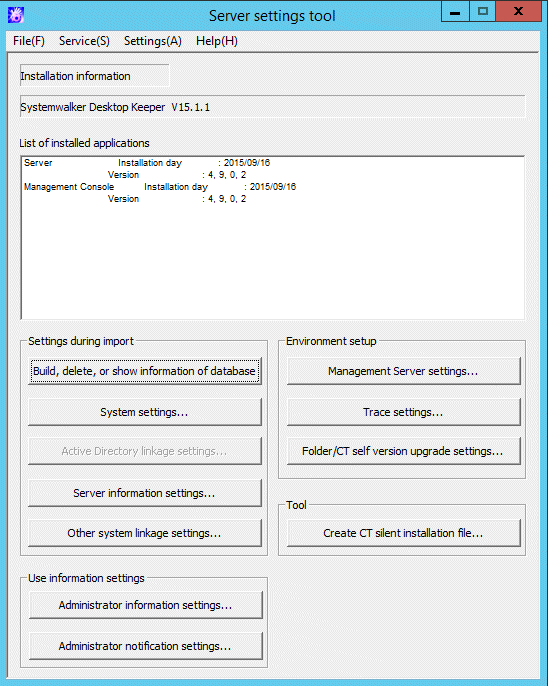
The following describes the menu bar in the Sever settings tool window.
Menu bar | Function summary | ||
|---|---|---|---|
File | End | To exit Sever Setting Tool. | |
Service | Confirm Service Status | To display the operation status of Level Control Service and Server Service on the target server. | |
Start Service | To start Level Control Service and Server Service on the target server. | ||
Stop Service | To stop Level Control Service and Server Service on the target server. | ||
Settings | Execute Active Directory Linkage | To execute the processing of Active Directory Linkage. | |
Execute Systemwalker Desktop Patrol Linkage | To execute the processing of linking with Systemwalker Desktop Patrol. | ||
Change Password | To modify the password of primary administrator; Specify the password within 32 single-bytes alphanumeric characters and symbols. The following symbols cannot be specified: & < > | \ " ~ ' ? : ^ | ||
Trace Server Settings Tool | OFF | Trace of Sever Setting Tool will not be collected. | |
Summary | Trace of Sever Setting Tool will be collected in summary mode. | ||
Details | Trace of Sever Setting Tool will be collected in details mode. | ||
Help | Online Help | To display the online manual of Systemwalker Desktop Keeper. | |
Version Information | To display copyright information and version information. | ||
To close the Sever settings , select End of the File menu.
The steps for configuring the server environment after the installation of a Management Server/Master Management Server and database construction are as follows:
Note
When using after the operation has been started, the service should be stopped.
If the service is not started in the settings at installation, it is not needed to stop the service. However, if the Sever Setting Tool is used to perform settings after the operation has been started, the services of the Management Server/Master Management Server should be stopped. There is no need to stop service when performing the following settings:
Administrator information setting
Administrator notification setting
Generate CT silent installation file
To stop services, you must exit all Management Consoles
During connection to the Management Console, the Management Server or Master Management Server determines whether the source address for the connection is correct.
For this reason, you must exit all Management Consoles before restarting the services of the Management Server or Master Management Server, and then reconnect afterwards.
Connection will fail if you attempt to connect to the Management Server without exiting the Management Console. If this happens, exit the Management Console and reconnect.
Exiting the Management Console will take the amount of time specified in the setting below:
Server settings tool > Management Server Settings > Timeout value of communication between servers
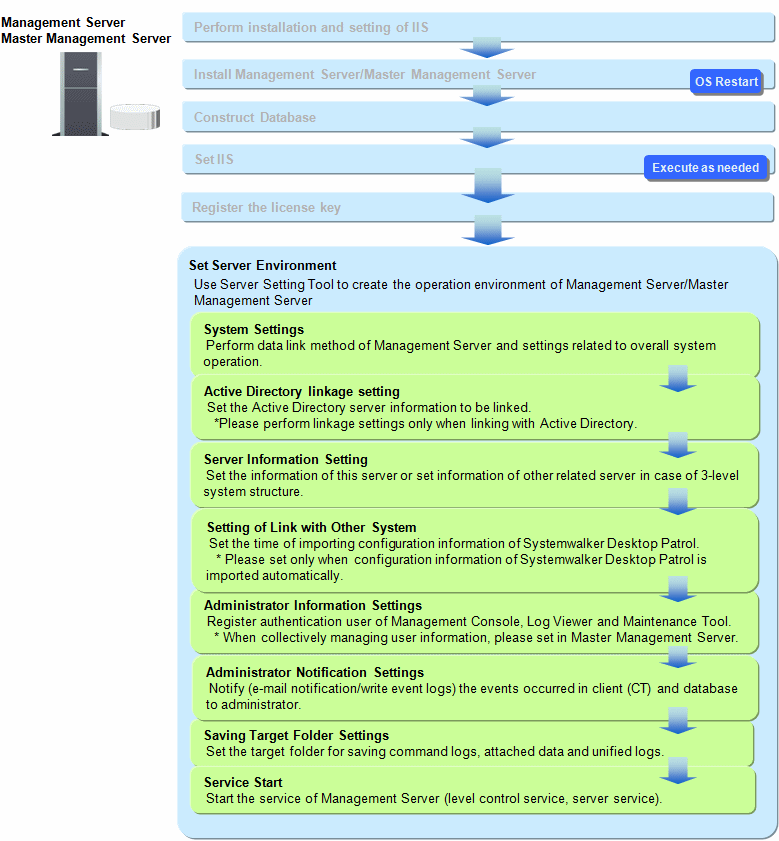
The method to start service of the Management Server is as follows:
Select Start Service from the Service menu of the Sever settings tool window.
After the service startup confirmation window is displayed, click the OK button.
Select Confirm Service Status from the Service menu of the Sever settings tool window to check if the service has been started.
Note
Log in to the web console after the service has been started
After the service of the Management Server has been started, log in to the Web Console and display the status window after executing the procedure in "2.5 Settings of PC with Web Browser Installed". When not logged in, the following error may be output to the event log:
Event ID: 3403s Type: Error Source: SWDTK_LC
Refer to "Display Status Window" in the Systemwalker Desktop Keeper User's Guide for Administrator for details on how to log in to the Web Console.
Perform the settings related to overall system operation of Systemwalker Desktop Keeper Management Server.
Note
In 3-level system structure, perform the same settings in all Management Servers.
The system setting procedure is as follows:
Click the System settings button from the menu of Sever Setting Tool.
The System Setting window is displayed.

Item Name | Description | |
|---|---|---|
Active Directory linkage | To set whether to perform Active Directory Linkage or not.
When "Not execute Active Directory linkage" is selected, the configuration information of Systemwalker Desktop Patrol cannot be imported. In addition, the information of the product cannot be output to Systemwalker Desktop Patrol. After using Systemwalker Desktop Keeper and when changing the setting of active directory linkage, refer to the "Change Import Method of Configuration Information" in the Systemwalker Desktop Keeper User's Guide for Administrator. | |
Status when creating user | For a new user of Active Directory, select Do not Apply User Policy when importing under the Not apply user policy status. | |
Operation for CT/User who does not register to Active Directory | Specify the handling of client (CT) and user ID not registered to Active Directory. (Handle client (CT)/user ID under local management.) This setting has been specified at the installation of the Management Server. Therefore, set when changing the setting at the installation of the Management Server.
| |
View CT registered location | Select whether to acquire client (CT) location information through Active Directory or through corresponding files.
| |
Manage user information | In a 3-level system structure, the setting of whether to perform collective management of the user policy information in the Master Management Server or not will be configured. Because this setting has been specified when the Management Server is installed, perform the setting when changing the setting at the time of Management Server installation.
| |
Item Name | Description |
|---|---|
MAC Address | Set whether the MAC address will also be taken as the judgment item for client (CT) consistency at client (CT) registration (re-registration) apart from computer name.
|
Owner | Set whether the owner information will also be taken as the judgment item for client (CT) consistency at client (CT) registration (re-registration) apart from the computer name.
|
OS Type | Set whether the OS type will also be taken as the judgment item for client (CT) consistency at client (CT) registration (re-registration) apart from computer name. In addition, Service Pack or version type will not be taken as consistency judgment condition.
|
Item Name | Description |
|---|---|
Display all groups (display forward compatibility) | To display the group tree that is displayed when Management Console or Log Viewer is started. |
Display group with management authority only | To display only the group that has administrator authority when Management Console or Log Viewer is started. |
Item Name | Description |
|---|---|
Manage under the root directory (display forward compatibility) | To directly manage the client (CT) that is newly registered to Management Server and the client (CT) that does not belong to any group under the Root directory group. |
Manage under the group that is not configured | To directly manage the client (CT) that is newly registered to Management Server and the client (CT) that does not belong to any group under the unconfigured group. Perform the settings when the following operations are performed:
Note About the status window and Log Viewer Department administrator cannot view the group that is not configured. Only the system administrator can view the group that is not configured. About Log Analyzer or Report Output Tool Even this setting has been performed in Log Analyzer or Report Output Tool, the client (CT) will not be managed in the "Unconfigured" group, but in the "root" group instead. |
Item Name | Description |
|---|---|
Manage | To manage the information of remote connection to physical PC and virtual PC. |
Not manage | Not manage the information of remote connection to physical PC and virtual PC. |
Item | Description |
|---|---|
Shift-JIS (not selectable) | Specify Shift-JIS as the encoding format for I/O files. |
UTF-8 | Specify UTF-8 as the encoding format for I/O files. |
Confirm the content of settings and change according to the needs. Click the Set button.
When linking with Active Directory, set the server information of the Active Directory to be linked.
The steps for Active Directory linkage setting are as follows.
Click Active Directory linkage settings in the menu of the Sever settings tool.
The Active Directory Linkage Settings window is displayed.
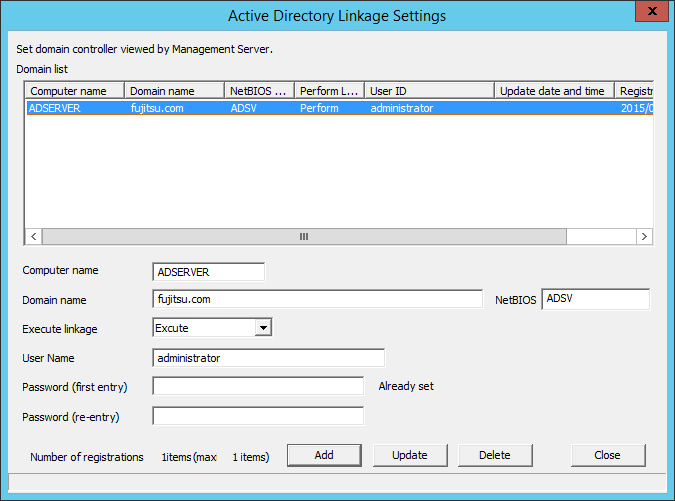
Item Name | Description |
|---|---|
Computer name | Enter the computer name of the Active Directory to be linked. Up to 15 single-byte characters can be entered. Only single-byte alphanumeric characters and hyphen "-" can be entered (Hyphen "-" should not be specified at the beginning or the end). When computer name has been omitted, NetBIOS name will be acquired according to the domain address and registered to the database. "(Automatic Judgment)" will be displayed on the window. |
Domain name (required) | Enter the domain name of the Active Directory to be linked. Specify up to 155 halfwidth alphanumeric characters, periods and hyphens (however, do not specify periods or hyphens at the beginning or at the end). IP address and NetBIOS domain name cannot be entered. Specification example: desktopkeeper.domain.com There is only 1 Active Directory server (domain) that can be linked. |
NetBIOS name (required) | NetBIOS name. If you click Add or Update with no value is specified, the DNS will be browsed based on Domain name and the NetBIOS name will be obtained. If the NetBIOS name cannot be obtained, you will need to specify it manually. Specify up to 16 halfwidth characters and the following symbols: ~ ! @ # $ % ^ & ( ) _ - { } [ ] ' . / |
Execute linkage (required) | Set to execute or stop Active Directory linkage.
|
User Name (required) | Enter the user name registered in Active Directory for viewing the information of Active Directory (before @ of the logon name of user in Active Directory). Up to 40 single-byte characters can be entered. Characters that can be entered include single-byte alphanumeric characters, spaces and the following symbols: ! # $ % & ' ( ) - . ^ _ ` { } As long as the user is registered in Active Directory, you will be able to link with Active Directory no matter what user is specified. |
Password (first entry) (required when adding) | Enter the password of the above user name. Up to 32 single-byte characters can be entered. Characters that can be entered include single-byte alphanumeric characters, spaces and the following symbols: ` ~ ! @ # $ % ^ & * ( ) _ + - = { } | [ ] \ : " ; ' < > ? , . / |
Password (re-entry) (required when adding) | In order to avoid wrong registration, enter the password again. |
Enter the required setting items, and click the Add button.
Click the Close button.
Information of the server will be registered during initial installation. In a 3-level system structure, information of other relevant servers will be set.
Steps to set server information are as follows:
Click the Server information settings button in the menu of Sever settings tool.
The Server Information Settings window is displayed.
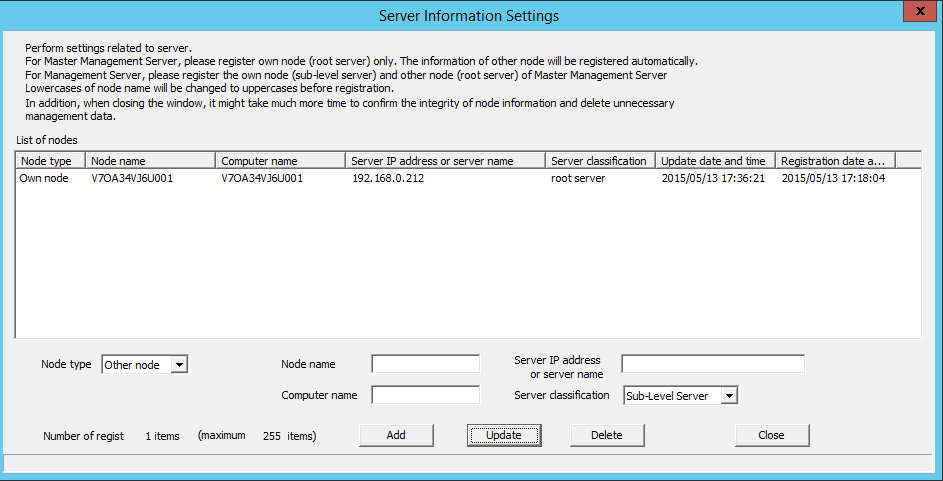
Item Name | Description |
|---|---|
Node type | Select the classification of the server node to be set.
In a 3-level Master Management Server: Information of other nodes will be automatically registered when the communication with Management Server is started. Therefore, it is not necessary to set the information of other nodes. In a 2-level the Management Server: Register only the local node and the node of Master Management Server. Do not set the node of other Management Server. |
Node name | Enter the node name of the server being set. Up to 36 single-byte characters can be entered. Only single-byte alphanumeric characters and hyphen "-" can be entered (hyphen "-" should not be specified at the beginning or the end). Single-byte lower-case letter will be automatically converted to single-byte upper-case letter. It will automatically set as the local computer name under local node, but will set to "NODE" when it is unable to acquire from the system or the computer name exceeds 16 characters. Set again at this time if necessary. |
Computer name | When the node is classified as local node, enter the computer name of the server. When the node is classified as other node, enter the computer name of Master Management Server. Up to 15 single-byte characters can be entered. Only single-byte letters, numbers and hyphen "-" can be entered (hyphen "-" should not be specified at the beginning or the end). Under local node, the computer name will be set automatically. However, when it is unable to acquire from the system or the computer name exceeds 16 characters, it will be set to "COMPUTER". Set again at this time if necessary. The computer name set here will be displayed in the CT group of the Management Console. |
Server IP address or server name | When the node is classified as local node, enter the IP address of the server. When the node is classified as other node, enter the IP address of the Master Management Server. In addition, under local node, the IP address of the computer will be set automatically during construction of the database. However, when it is unable to acquire from the system or the IP address has not been set at the time of registration, it will be set to loop back address. Reset at this time.
Note: It is necessary to be able to resolve the host name of the Management Server or Master Management Server on each machine. Otherwise, communication will not be possible between the Master Management Server and Management Server, and between the Management Server or Master Management Server and the client (CT). Note: IPv6 addresses can be abbreviated using RFC 5952-compliant format. |
Server classification | Enter the classification of server.
In initial status, it will be set to "Root Server" (not relying on construction options). |
Update date and time | To display the date on which the server information is updated. The date of updating other nodes (Master Management Server) in a Management Server of a 3-level system is blank. In initial status, the date of database construction will be displayed in the list. |
Registration date and time | To display the date on which the server information is registered. In initial status, the date of database construction will be displayed in the list. |
Enter the required setting items and click the Add button.
Click the Close button.
Perform the setting when Systemwalker Desktop Patrol configuration information is imported automatically.
Click the Other system linkage settings button in the menu of Sever Setting Tool.
The Other System Linkage Settings window is displayed.
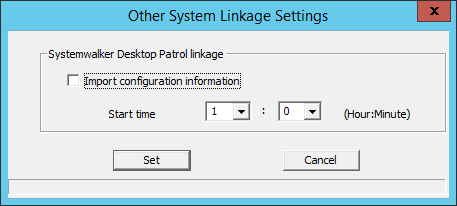
Item Name | Description |
|---|---|
Import configuration information | Select this when the configuration information of Systemwalker Desktop Patrol is imported automatically. |
Start time | Time to start the automatic import. Only takes effect if Import configuration information is selected. Note Do not set the time frame when the Management Server service is stopped. |
Note
If the configuration information of Systemwalker Desktop Patrol is imported automatically, it is necessary to specify the URL of Systemwalker Desktop Patrol in URL of Desktop Patrol under Environment Setup in the global navigation of the web console.
Register the authenticated user of the Management Console, Log Viewer, Log Analyzer, status window, environment setup, report output tool, backup tool and restoration tool. In addition, when department management mode is used, register the department administrator. During installation, make sure to register the administrator whose access authority is "Management Console and Log Viewer".
However, in case of collectively managing user policy (user information) in the Master Management Server with a 3-level structure, if setting has been performed in the Master Management Server, then it is no need to set in the Management Servers. After the operation has been started, it will be reflected to all Management Servers automatically.
There are following two methods for the procedure of administrator information settings:
Register administrators one by one;
Use CSV file to register administrators collectively
Register administrators one by one
Click the Administrator information settings button in the menu of Sever Setting Tool.
The Administrator Information Settings window is displayed.
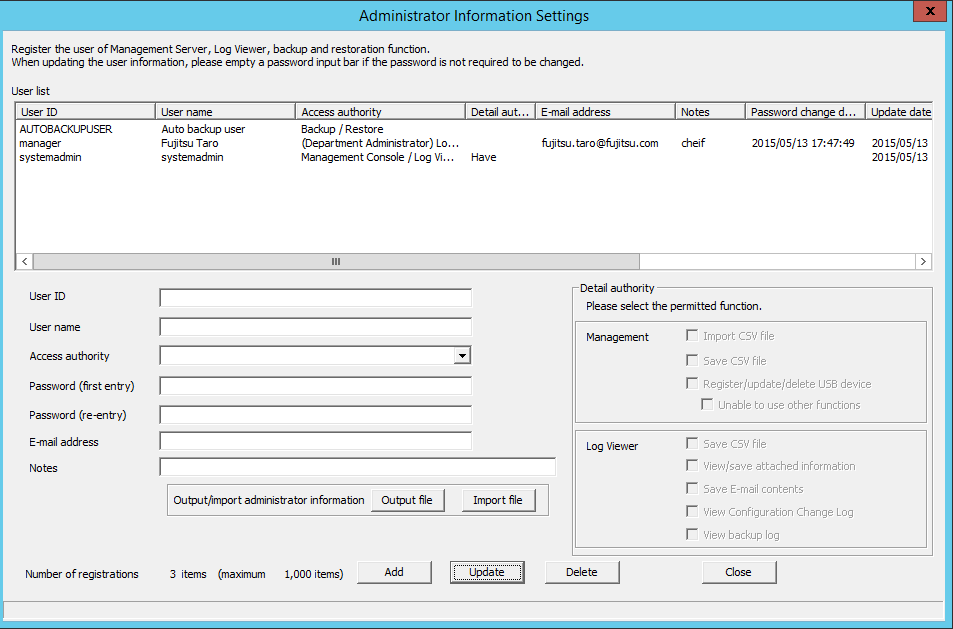
Item Name | Description | |||
|---|---|---|---|---|
User ID | Up to 40 single-byte characters (20 double-byte characters) can be entered. It cannot contain spaces, halfwidth katakana, and the following symbols: & < > | \ " ~ ' ? : ^ Double-byte or single-byte spaces should not be entered. It is not case-sensitive. | |||
User name | Up to 40 single-byte characters (20 double-byte characters) of alphanumeric characters, Chinese characters and symbols can be entered. | |||
Access authority | Select the following authority.
| |||
Password (first entry) | Specify up to 32 halfwidth alphanumeric characters, except for spaces and the following symbols: & < > | \ " ~ ' ? : ^ | |||
Password (re-entry) | In order to avoid wrong registrations, re-enter the password. | |||
E-mail address | Enter the E-mail address of registered user. Specify up to 255 bytes (can be a combination of fullwidth and halfwidth characters), except for the following: < > ( ) [ ] \ : ; " | |||
Notes | Up to 256 single-byte characters (128 double-byte characters) of alphanumeric characters, Chinese characters and symbols can be entered. | |||
Detailed authority | Management | Import CSV file | Select when granting the following execution authority in the Management Console to the registered users (selected).
| |
Save CSV file | Select when granting the following execution authority in Management Console to the registered user (selected).
| |||
Register/ update/ delete USB device | Select when granting the operation authority of the USB device individual identification function in the Management Console to the registered user (selected). | |||
| Unable to use other functions | Select when granting registration/modification/deletion authorities to USB device through Management Console (selected). This can only be set when the setting of Access Authority is (Department Administrator) Management Console. | ||
Log Viewer | Save CSV file | Select when granting the execution authority of CSV export log in the Log Viewer to the registered user (selected). | ||
View/save attached information | Select when granting the following execution authorities in the Log Viewer to the registered user (selected):
| |||
Save E-mail contents | Select when granting the following execution authorities in the Log Viewer to registered user (selected):
| |||
View Configuration Change Log | Select when granting the view authorities of configuration change logs in the Log Viewer to the registered user (selected). | |||
View backup log | Select when granting the view authorities of backup log logs in the Log Viewer to the registered user (selected). | |||
Password change date | Display the last date on which the password is changed. | |||
Update date and time | Display the date on which the user information is updated. | |||
Registration date and time | Display the date on which the user information is registered. | |||
Enter necessary setting items and click Add.
Repeated the Step 2. for continuous setting.
Click Close.
Point
When modifying administrator information
When it is not necessary to change the password when modifying administrator information, leave the password input field blank (Password (first entry), Password (re-enter)).
When it is expected to change the user ID only instead of changing other conditions such as user and authority, add a new administrator. Set the same conditions for other input items.
About automatic backup and deletion of user
Register the following information during database construction, database migration and restoration for the administrator to perform automatic backup and deletion.
User ID: AUTOBACKUPUSER
User Name: Auto backup user
Access Authority: Backup / Restore
Only password can be changed for automatic backup and deletion user. When the initial value of the password is changed, change the password.
Note
Deleting the administrator information
Deleting the department administrator causes department administrator information to be deleted as well.
When deleting the system administrator or department administrator, they are managed as separate persons even if created again under the same name. If the department administrator will use the Log Viewing Database, you should restore the latest administrator information to the Log Viewing Database.
Method to register administrators collectively
The following describes how to register administrators collectively by using the administrator information file.
For administrator information file, refer to "Administrator Information File" in the Systemwalker Desktop Keeper Reference Manual.
Click the Administrator information settings button in the menu of Sever Setting Tool.
Select Import file. The following window will be displayed.
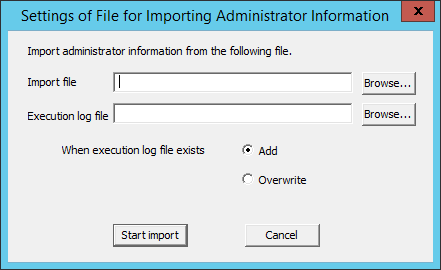
Item Name | Description |
|---|---|
Import file (required) | Specify the created CSV file. The specification method is as follows.
|
Execution log file (required) | Specify the file to output execution result when importing CSV file. The error during import will also be output in this file. The specification method is as follows.
|
When execution log file exists (required) | In Execution log file, select the exporting method when the file for log output has been already specified.
|
Enter all the items and click the Start Import button. The Display the import status of administrator information window will be displayed, and processing will be started.
Confirm the information displayed in the execution status, and click the OK button.
This section describes how to output administrator information.
For administrator information file, refer to "Administrator Information File" in Systemwalker Desktop Keeper Reference Manual.
Click the Administrator information settings button in the menu of Sever Setting Tool.
Select Output file. The following window will be displayed.
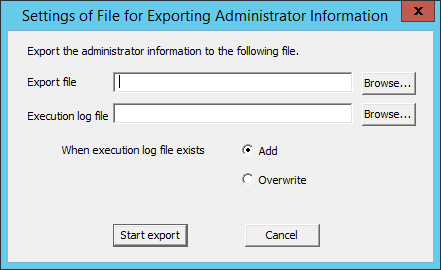
Item Name | Description |
|---|---|
Export file (required) | Specify the CSV file to be output. The specification method is as follows.
|
Execution log file (required) | Specify the file to output execution result when importing CSV file. The error during import will also be output in this file. The specification method is as follows.
|
When execution log file exists (required) | In Execution log file, select the exporting method when the file for log output has been already specified.
|
Enter all the items and click the Start export button.
Events occurred in the client (CT) and database can be notified to the administrator (E-mail notification, writing to event log).
Events that can be notified and timing of notification are as follows:
Notification of prohibition operation and violation operation in the client (CT).
Notify immediately after prohibition logs are collected.
System administrator and department administrator can be notified by E-mail.
Notification of database exception
Notify when the threshold of database space and disk space is reached.
Notify immediately when there is no available database space and it is unable to write information into the database.
Only notification to the system administrator by E-mail is allowed.
Notification of client (CT) information
When the client (CT) is started, notify immediately when Management Server detects modification of client (CT) information.
System administrator and department administrator of CT group can be notified by E-mail.
When notifying the department administrator, refer to "Allocate Department Administrator" in Systemwalker Desktop Keeper User's Guide for Administrator.
The steps to set administrator notification are as follows:
Click the Administrator notification settings button in the menu of Sever Settings Tool.
The Administrator Notification settings window is displayed.

Set whether the E-mail notification to administrator or writing to event log exists when each prohibition log is detected.
The following types of logs can be set:
Application startup prohibition
Printing prohibition
Logon prohibition
PrintScreen key prohibition
E-mail attachment prohibition
FTP operation prohibition
When FTP server connection prohibition log is detected.
Web operation prohibition
When URL access prohibition log, Web upload prohibition log and Web download prohibition log are detected.
Clipboard operation prohibition
When clipboard operation prohibition log is detected.
Linkage application log violation
Note: In case of linkage application log (classified as violation)
Device configuration change log violation
Note
Email notifications for the smart device (agent) administrator and writing to the event log
The following violation logs recorded using the smart device (agent) belong to the Device configuration change log, however, email notifications to the administrator and writing to the event log will not be performed.
Wi-Fi connection prohibition log
Bluetooth connection prohibition log
Application usage prohibition log
As actions when all logs are detected, the contents that can be set are as follows:
Item Name | Description |
|---|---|
E-mail notification to administrator |
|
Write event log |
|
Set whether to notify the administrator by E-mail or write to event log when the disk for writing collected log is insufficient.
Types of space that can be set are as follows:
Notification when DB space is insufficient
1. When available space in database becomes insufficient, information cannot be written to the database.
2. When available space in database is lower than the value set in the [Threshold value when the space is insufficient].
The database availability check is performed at the following timing:
- When the date is changed (0:00)
Notification when the disk space is insufficient
Disk space is insufficient, i.e. the available space of the disk in which the following specified folders are located is lower than the value set in Threshold value when the space is insufficient.
- Attached data saving folder
- E-mail content folder
- Command log folder
- Collective log sending folder
- Trace log folder
- Trouble investigation data saving target folder
- Automatic backup target folder
When space is insufficient, the contents that can be set are as follows:
Item Name | Description |
|---|---|
E-mail notification to administrator |
|
Write event log |
|
Threshold value when the space is insufficient Note: When database space is insufficient | Set the value for domain value of notification at insufficiency by specifying % (unit: insufficiency %). Positive integer within 5-20 can be set. Enter when at least one item of E-mail notification to administrator and Write event log is set to Yes. Initial value is 5%. |
Threshold value when the space is insufficient Note: When disk space is insufficient | Set the value for domain value of notification at insufficiency by specifying % (unit: insufficiency %) or capacity (unit: insufficiency MB). Enter when at least one item of E-mail Notification to Administrator and Write event log is set to Yes. When both domain value values of notification have been set for both % and capacity specification at the time of insufficiency, the domain value of smaller capacity will be effective. Positive integer within 1-20 can be set in % specification. Initial value is less than 3%. Positive integer within 100-99999 can be set in capacity specification. There is no initial value. In addition, when entering 100MB, the value calculated by the following calculation formula can be set. |
Set this to notify the administrator by email and write to the event log on startup of the client (CT) if the client (CT) information has been changed.
The notification content that can be set are as follows:
When the deviation exceeding the reference time exists
System time of the client (CT) and the system time of the Management Server have deviation that exceeds the standard time.
A check for deviations is performed upon communication with the Management Server during client registration or after the operating system starts up on the client.
Notification when the client information is abnormal
When intrinsic information "CTID" is detected on the client (CT) repeatedly.
Notify administrator and event log about the event described as "MAC Address Modification".
Repetition of "CTID" may occur when the master PC is used to extend the client (CT).
CT notification being collected and traced
When client (CT) that is collecting and tracking is detected.
By notifying the administrator the client (CT) in the status of trace and collection, this can be set as trace not collected by administrator.
Checking of the client (CT) during trace collection will be performed at the following timing:
- When the Systemwalker Desktop Keeper service starts (including when the server starts)
- When the date changes (0:00)
The setting will be valid within 1 month after the last logon date. Therefore, no notification will be issued after it exists in the environment that has not been cancelled by the file server for more than one month.
For the client (CT) monitoring action, the contents that can be set are as follows:
Item Name | Description |
|---|---|
E-mail notification to administrator |
|
Write event log |
|
Notification (note) | Taking minute as unit, specify the time difference between the system time of the client (CT) and the system time of the Management Server. Positive integer within 30-999 can be set. Enter when at least one between E-mail notification to administrator and Write event log is set to Yes. Initial value is 60 minutes. |
Note: Setting items when Deviation that Exceeds Standard Time Exists.
Note
Email notifications for the smart device (agent) administrator and writing to the event log
Email notifications to the administrator and writing to the event log will not be performed for the following notification items in the smart device (agent):
When the deviation exceeding the reference time exists
Notification when the client information is abnormal
CT notification being collected and traced
Click E-mail addressee settings. The E-mail Addressee Settings window will be displayed.
Specify the required information for email notifications to the administrator.
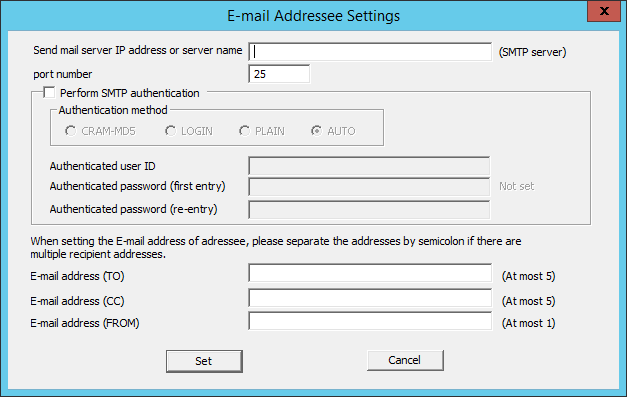
Item Name | Description | |
|---|---|---|
Send mail server IP address or server name | When notifying the administrator by E-mail, enter the SMTP server name.
Note: IPv6 addresses can be abbreviated using RFC 5952-compliant format. | |
port number | Enter the port number used for sending E-mail. Initial value is 25. | |
Perform SMTP authentication | Set whether to perform SMTP authentication in the communication with the E-mail sending server.
| |
| Authentication method | Select authentication method when Perform SMTP authentication is set to Yes. The methods that can be selected are as follows:
When AUTO is selected, authentication method will be automatically determined according to the following sequence. The initial value is AUTO. 1) CRAM-MD5 |
Authentication user ID | Enter the user ID when carrying out SMTP authentication in the communication with the E-mail sending server. Specify up to 40 halfwidth characters. | |
Authentication password (first entry) | Enter the password of SMTP authentication user ID. Specify up to 32 halfwidth characters, except for kana. | |
Authentication password (re-entry) | Re-enter the password in order to avoid wrong registration. | |
E-mail address (TO) | Enter the address of E-mail recipient (To) when notifying the system administrator by E-mail. Specify up to 5 email addresses using up to 255 halfwidth characters, except for the following symbols: \ " ( ) [ ] < > , . ; : Specify up to 5 email addresses. Use a semicolon (;) to separate email addresses. | |
E-mail address (CC) | Enter the address of E-mail recipient (CC) when notifying the system administrator by E-mail. It is not required to enter when not sending to CC. Specify up to 5 email addresses using up to 255 halfwidth characters, except for the following symbols: \ " ( ) [ ] < > , . ; : Specify up to 5 email addresses. Use a semicolon (;) to separate email addresses. | |
E-mail address (FROM) | Enter the address of the E-mail sender when notifying the system administrator by E-mail. Specify up to 255 halfwidth characters, except for the following symbols: \ " ( ) [ ] < > , . ; : | |
Click Email title settings - the Email title settings window is displayed.
Specify the title of email notifications for the administrator.
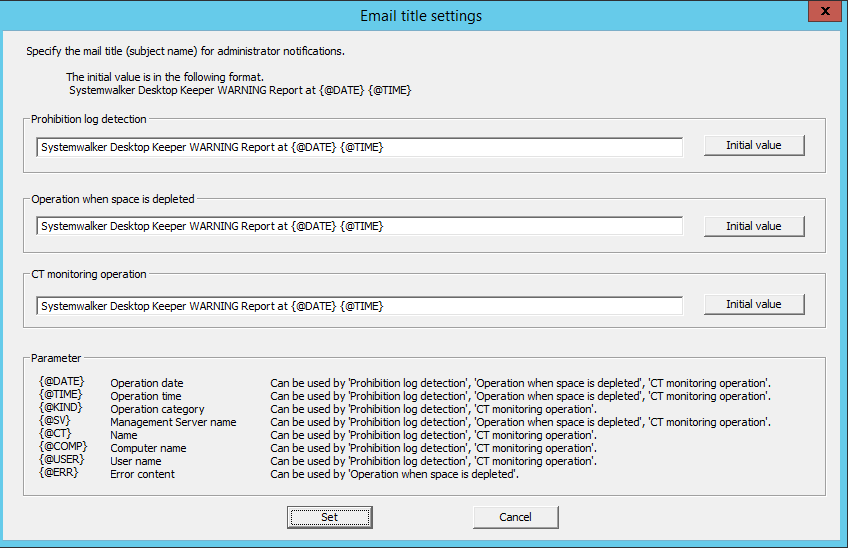
Item Name | Description |
|---|---|
Prohibition log detection (required) | Title of email notifications for the administrator sent when prohibition logs are detected. Specify up to 255 bytes (can be a combination of fullwidth and halfwidth characters). The initial value is "Systemwalker Desktop Keeper WARNING Report at {@DATE} {@TIME}". To restore the initial value, click Initial value.
|
Operation when space is depleted (required) | Title of email notifications for the administrator sent when depletion of space is detected. Specify up to 255 bytes (can be a combination of fullwidth and halfwidth characters). The initial value is "Systemwalker Desktop Keeper WARNING Report at {@DATE} {@TIME}". To restore to the initial value, click Initial value. Refer to "Parameters that can be set" for details. |
CT monitoring operation (required) | Title of email notifications for the administrator sent when client (CT) information has been changed. Specify up to 255 bytes (can be a combination of fullwidth and halfwidth characters). The initial value is "Systemwalker Desktop Keeper WARNING Report at {@DATE} {@TIME}". To restore to the initial value, click Initial value. Refer to "Parameters that can be set" for details. |
The parameters that can be set for each notification are described below.
Parameter | Content in the email title if specified | Prohibition log detection | Operation when space is depleted | CT monitoring operation |
{@DATE} | Operation date for logs notified to the administrator | Y | Y | Y |
{@TIME} | Operation time for logs notified to the administrator | Y | Y | Y |
{@KIND} | Type of log notified to the administrator | Y | N | Y |
{@SV} | Name of the (integrated) server where logs notified to the administrator have accumulated | Y | Y | Y |
{@CT} | Name of the client (CT) where the operations for which the logs are notified to the administrator were performed | Y | N | Y |
{@COMP} | Name of the client (CT) computer where the operations for which the logs are notified to the administrator were performed | Y | N | Y |
{@USER} | Name of the user that performed the operations for which the logs are notified to the administrator were performed | Y | N | Y |
{@ERR} | Errors that have occurred | N | Y | N |
Enter the required setting items and click the Set button.
E-mail notification format
Format of notifying events occurred in the client (CT) and database to administrator by E-mail is as follows:
When using a dual stack client (CT), only IPv4 addresses are displayed in the device column.
Item Name | Format |
|---|---|
E-mail Title | Systemwalker Desktop Keeper WARNING Report at yyyy/mm/dd hh:mm:ss Note: If the email title parameter still contains the initial value. |
Text (Subject) |
|
Event log display format
This describes the format of the event occurred in the client (CT) and database displayed in the event viewer of Windows.
The notified information is displayed in "Application Log" of the event log of Windows. When using a dual stack client (CT), only IPv4 addresses are displayed in the device column. The displayed contents are describes as follows:
Item Name | Description |
|---|---|
Category | [Warning] will be displayed. |
Date | Date of notification information displayed in event viewer. |
Time | Time of notification information displayed in event viewer. |
User | User ID. |
Computer Name | Computer name. |
Source | [SWDTK] will be displayed. |
Category | [None] will be displayed. |
Event ID | The following serial numbers will be displayed.
For details, refer to "Message Output with Event Log" in Systemwalker Desktop Keeper Reference Manual. |
Explanations | The following information will be displayed.
|
Set all kinds of folders in the Systemwalker Desktop Keeper Management Server.
The steps of setting the saving target folder are as follows:
Click the Folder/CT self version upgrade settings button in the menu of Sever Setting Tool.
The Folder/CT Self Version Upgrade Settings window is displayed.
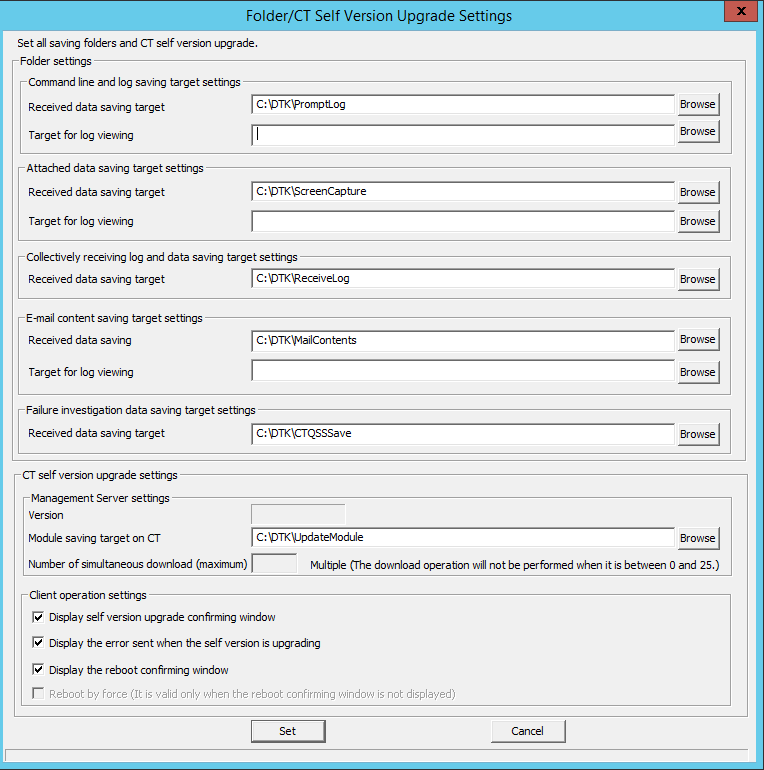
Confirm the initial value of saving target of the following information displayed in Folder settings. Click the Browse button to modify the saving target.
(It is not necessary to set CT self-version upgrade settings here. For the setting content, refer to "4.7 Upgrading the client (CT)".)
Item Name | Description | |
|---|---|---|
Command line and log saving target settings | The method to specify the saving target folder of command log in Management Server is as follows:
The length of the full path that can be specified is no more than 96 single-byte characters (48 double-byte characters). | |
| Received data saving target | Specify the folder to save the data in operation. |
Target for log viewing | Specify the folder to save data for log viewing. Specify when creating the log viewing database and restoring operation logs. | |
Attached data saving target settings | Specify the saving target folder of additional data (screen capture data, original backup file, and clipboard operation original backup file) in the Management Server. The specification method is as follows:
| |
| Received data saving target | Specify the folder to save the data in operation. |
Target for log viewing | Specify the folder to save data for log viewing. Specify when creating the log viewing database and restoring operation logs. | |
Collectively receiving log and data saving target settings | Specify the saving target folder of collective log data in the Management Server. The specification method is as follows:
The length of the full path that can be specified is no more than 96 single-byte characters (48 double-byte characters). | |
E-mail content saving target settings | Specify the saving target folder of E-mail contents data (E-mail text and attachment) in the Management Server. The specification method is as follows:
The length of the full path that can be specified is no more than 96 single-byte characters (48 double-byte characters). | |
| Received data saving target | Specify the folder to save the data in operation. |
Target for log viewing | Specify the folder to save data for log viewing. Specify when creating the log viewing database and restoring operation logs. | |
Failure investigation data saving target settings | Specify the saving target folder of QSS (Trouble Investigation Data) collected remotely in the Management Server. The specification method is as follows:
The length of the full path that can be specified is no more than 96 single-byte characters (48 double-byte characters). | |